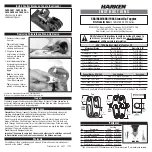
FluoroMax-3 v. 3.1 (6 Mar 2006)
FluoroMax
®
-P Phosphorimeter Operation
9-9
Excitation
Emission
These are similar to the standard excitation, and emission synchronous
scans. Among the changes are that the
Integration Time
field is removed,
and instead are data-entry fields for
Sample window
,
Delay after flash
,
Time per flash
, and
Flash count
. These four fields are described above,
in the Theory of Operation section, and shown below.
Above is a
Phosphorimeter
area with a typical set of parameters for the emission of
EuCl
3
. Use an excitation monochromator set to 393 nm; the emission monochromator
should start at 570 nm, end at 750 nm, with an increment of 1 nm.
Decay by
Delay
Decay by
Window
These produce a decay of phosphorescence over time.
Decay by Delay
varies the flash’s
Delay after flash
in order to construct the decay curve.
Decay by Window
varies the length of the
Sample window
while taking
data.
Above is a
Phosphorimeter
area showing typical parameters for the phosphorimeter
decay of EuCl
3
. Set the emission monochromator to 590 nm and the excitation mono-
chromator to 393 nm.
Anisotropy phosphorimeter scans run the automated polarizers as well.
Summary of Contents for FluoroMax-3
Page 5: ...FluoroMax 3 v 3 1 3 Mar 2006 v 15 Declaration of Conformity 15 1 16 Index 16 1...
Page 6: ...FluoroMax 3 v 3 1 3 Mar 2006 vi...
Page 18: ...FluoroMax 3 v 3 1 3 Mar 2006 Introduction 0 12...
Page 36: ...FluoroMax 3 v 3 22 Feb 2005 System Description 2 8...
Page 96: ...FluoroMax 3 v 3 1 3 Mar 2006 Maintenance 6 12...
Page 156: ...FluoroMax 3 v 3 1 6 Mar 2006 Automated Polarizers 10 22...
Page 208: ...FluoroMax 3 v 3 1 6 Mar 2006 Bibliography 14 4...
Page 210: ...FluoroMax 3 v 3 1 6 Mar 2006 Declaration of Conformity 15 2...
















































